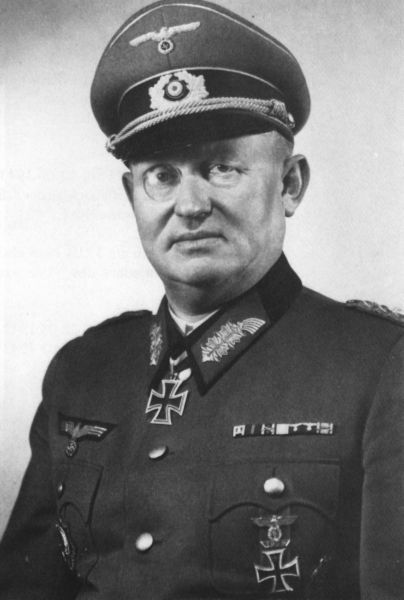Lüttwitz, Freiherr von, Heinrich (General der Pz)
- Date of birth:
- December 6th, 1896 (Krumpach-Trebnitz/Silesia, Germany)
- Date of death:
- October 9th, 1969 (Neuburg an der Donau/Bavaria, Germany)
- Nationality:
- German
Biography
General der Panzertruppen Heinrich Diepold Georg Freiherr von Lüttwitz
Promotions:
06.08.1914: Fahnenjunker
01.12.1914: Leutnant (mit Patent vom 18.06.1915)
Oberleutnant
01.02.1931: Rittmeister
Major
01.02.1939: Oberstleutnant
01.10.1941: Oberst
01.12.1942: Generalmajor
01.06.1943: Generalleutnant
01.11.1944: General der Panzertruppe
Career:
06.08.1914: Entered service as a Fahnenjunker.
05.10.1914: WIA
01.12.1914: Commisioned as a Leutnant in Ulan-Regiment 1.
01.09.1939-04.09.1940: Kommandeur of Kradschutzen-Bataillon 59.
02.09.1939: severely WIA
04.09.1940-02.07.1941: Kommandeur of I.Bataillon / Schützen-Regiment 11
02.07.1941-01.06.1942: Kommandeur of Panzer-Grenadier-Regiment 59.
01.06.1942-01.10.1942: Kommandeur of 20. Schützen-Brigade.
01.10.1942-05.05.1943: Kommandeur of 20. Panzer-Division.
01.02.1944-31.08.1944: Kommandeur of 2. Panzer-Division.
20.08.1944: WIA
04.09.1944-08.05.1945: Kommandierender General of XXXXVII. Panzer-Korps
17.04.1945-01.07.1947: POW
Do you have more information about this person? Inform us!
- Period:
- First World War (1914-1918)
- Awarded on:
- May 18th, 1915
- Period:
- First World War (1914-1918)
- Awarded on:
- June 2nd, 1918
- Period:
- First World War (1914-1918)
- Awarded on:
- 1918
- Period:
- First World War (1914-1918)
- Awarded on:
- 1934
- Period:
- Second World War (1939-1945)
- Rank:
- Oberstleutnant (Lieutenant-colonel)
- Unit:
- Kommandeur, Aufklärungs-Abteilung 1, 1. Infanterie-Division
- Awarded on:
- September 20th, 1939
Had already received the Iron Cross 2nd Class on 18th May 1915.
- Period:
- Second World War (1939-1945)
- Rank:
- Oberstleutnant (Lieutenant-colonel)
- Unit:
- Kommandeur, Aufklärungs-Abteilung 1, 1. Infanterie-Division
- Awarded on:
- March 2nd, 1940
- Period:
- Second World War (1939-1945)
- Rank:
- Oberstleutnant (Lieutenant-colonel)
- Unit:
- Kommandeur, Schützen-Regiment 59, 20. Schützen-Brigade, 20. Panzer-Division
- Awarded on:
- August 1st, 1941
Had already received the Iron Cross 1st Class on 2nd June 1918.
- Period:
- Second World War (1939-1945)
- Rank:
- Oberstleutnant (Lieutenant-colonel)
- Unit:
- Kommandeur, Schützen-Regiment 59, 20. Schützen-Brigade, 20. Panzer-Division
- Awarded on:
- December 19th, 1941
Award 34/36.
According to other source the awarding date is 20-12-1941.
- Period:
- Second World War (1939-1945)
- Rank:
- Oberst (Colonel)
- Unit:
- Kommandeur, Schützen-Regiment 59, 20. Panzer-Division, XX. Armee-Korps, 3. Panzer-Armee, Heeresgruppe Mitte
- Awarded on:
- May 27th, 1942
1101st Award.
- Period:
- Second World War (1939-1945)
- Rank:
- Oberst (Colonel)
- Unit:
- Kommandeur, 20. Schützen-Brigade, 20. Panzer-Division
- Awarded on:
- August 29th, 1942
According to other source the awarding date is 31-8-1942.
- Period:
- Second World War (1939-1945)
- Awarded on:
- 1942
- Period:
- Second World War (1939-1945)
- Rank:
- Generalleutnant (Major-general)
- Unit:
- Kommandeur, 2. Panzer-Division, 7. Armee, Heeresgruppe B
- Awarded on:
- September 3rd, 1944
571st Award.
Sources
- Photo 1: Wehrkundearchiv
- Photo: Deutsches Wehrkundearchiv
- - FELLGIEBEL, W.P., Elite of theThird Reich, Helion & Company Limited, Solihull, 2003.
- PATZWALL, K. & SCHERZER, V., Das Deutsche Kreuz 1941-1945, Band II, Verlag Klaus D. Patzwall, Norderstedt, 2001.
- THOMAS, FRANZ & WEGMANN, GüNTER, Die Eichenlaubträger 1940-1945, Biblio-Verlag, 1998.
- Kwasny A., Kwasny G., Die Eichenlaubträger 1940-1945 (CD), Deutsches Wehrkundearchiv, Lage-Waddenhausen, 2001
- Kursietis, Andris J., The Wehrmacht at War 1939-1945, Aspekt, The Netherlands, 1999
- Helden der Wehrmacht II, Sammelband (Miscellany), FZ-Verlag GmbH, München, Deutschland, 2003
- Berger, F., Mit Eichenlaub und Schwertern – Die höchstdekorierten Soldaten des Zweiten Weltkrieges, Selbstverlag Florian Berger, Wien, Österreich, 2002/03
- Axis Biographical Research
- BArch RH 7/338.




















